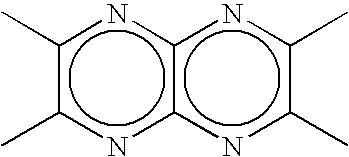Organic electroluminescent device and material for organic electroluminescent device
a technology of organic electroluminescence and organic el, which is applied in the direction of luminescnet screens, discharge tubes, organic chemistry, etc., can solve the problems of rapid deterioration in the performance of organic el devices and the inability to put organic el devices to practical use, and achieve excellent electron-accepting properties and electron mobility, excellent performance, and enhanced electron-accepting properties
- Summary
- Abstract
- Description
- Claims
- Application Information
AI Technical Summary
Benefits of technology
Problems solved by technology
Method used
Image
Examples
example
Example 1
Synthesis of Compound (I)
[0215]3 g of 3,3′-diaminobenzidine (a) and 6.13 g of 5,6-dichloro-2,3-dicyanopyrazine (b) were reacted in 150 ml of acetonitrile under heat reflux for 10 hours. The reaction fluid was filtered at room temperature, and the resulting solid phase was washed with 100 ml of acetonitrile, 200 ml of water, and 50 ml of MeOH. The resulting solids were dried at 40° C. under reduced pressure for 4 hours to obtain 3.13 g of a crude product (c). The crude product (c) was subjected to the mass spectrometry (FDMS) and found to have m / e=466, so that the crude product (c) was identified as the intended product.
[0216]Further, 3 g of the crude product (c) and 3.21 g of DDQ (d) were reacted in 150 ml of THF at room temperature for 7 hours. The resulting reaction fluid was filtered, and the resulting solids were washed with 100 ml of THF and 30 ml of hexane. The resulting solid was dried at 40° C. under reduced pressure for 4 hours to obtain 2.77 g of a compound
[0217]T...
example 2
Synthesis of Compound (A-1)
[0220]10 g of acenaphthenequinone (e) and 8.8 g of 5,6-diamino-2,3-dicyanopyrazine (f) were reacted in 250 ml of pyridine under heat reflux for 18 hours. The reaction fluid was filtered at room temperature, and the resulting solid phase was washed with THF, and then further with acetonitrile. The resulting solids were dried at 60° C. under reduced pressure for 8 hours to obtain 11 g of a compound (A-1). The compound (A-1) was subjected to the mass spectrometry (FDMS) and found to have m / e=306, so that the compound (A-1) was identified as the intended product. The product was purified by the sublimation purification. The reduction potential of the purified compound was measured in the same manner as that for Example 1, and thereby found to be −0.48 V (vs Fc+ / Fc).
[0221]
example 3
Synthesis of Compound (3)
[0222]5 g of 4-trifluoromethyl-1,2-phenylenediamine (g) and 6.21 g of 5,6-dichloro-2,3-dicyanopyrazine (b) were reacted in 200 ml of acetonitrile under heat reflux for 10 hours. The reaction fluid was filtered at room temperature, and the resulting filtrate was concentrated to obtain 8.2 g of a crude product (h). The crude product (h) was subjected to the mass spectrometry (GC-MS) and found to have m / e=302, so that the crude product (h) was identified as the intended product. Further 6 g of the crude product (h) and 4.48 g of DDQ (d) were reacted in 100 ml of THF at room temperature for 8 hours. 400 ml of hexane was added to the resulting reaction fluid, and then a precipitate was collected by filtration. The resulting solids were dried at 60° C. under reduced pressure to obtain 3.33 g of a compound (3).
[0223]The compound (3) was subjected to the mass spectrometry (GC-MS) and found to have m / e=300, so that the compound (3) was identified as the intended prod...
PUM
| Property | Measurement | Unit |
|---|---|---|
| mol % | aaaaa | aaaaa |
| light transmittance | aaaaa | aaaaa |
| transmittance | aaaaa | aaaaa |
Abstract
Description
Claims
Application Information
 Login to View More
Login to View More - R&D
- Intellectual Property
- Life Sciences
- Materials
- Tech Scout
- Unparalleled Data Quality
- Higher Quality Content
- 60% Fewer Hallucinations
Browse by: Latest US Patents, China's latest patents, Technical Efficacy Thesaurus, Application Domain, Technology Topic, Popular Technical Reports.
© 2025 PatSnap. All rights reserved.Legal|Privacy policy|Modern Slavery Act Transparency Statement|Sitemap|About US| Contact US: help@patsnap.com



